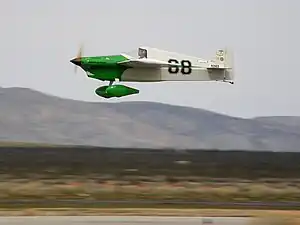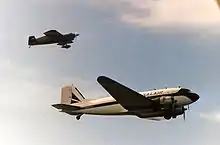Cassutt Special
The Cassutt Special is a single-seat sport and racing aircraft designed in the United States in 1951 for Formula One air races. Designed by ex-TWA captain Tom Cassutt, it is a mid-wing cantilever monoplane with fixed tailwheel undercarriage. The fuselage and tail are of fabric-covered steel tube construction, and the wings are built from plywood over wooden ribs.[1][2] An updated taper-wing design was first flown in 1971 on Jim Wilson's "Plum Crazy".[3]
| Cassutt Special | |
|---|---|
 | |
| Role | Formula 1 racing aircraft |
| Manufacturer | Homebuilt |
| Designer | Tom Cassutt |
| First flight | 1954 |



Design and development
The aircraft is built with a 4130 tubular steel spaceframe fuselage and a plywood-skinned wing with solid spruce spar and built-up ribs. The design lends itself well to modification, there being several different wing options of wood or composite construction.[1] Several different tails have been built, including T-tails.
The standard engine used for competition is the 100 hp (75 kW) Continental O-200, while other, lower-powered engines can be used for recreational flying, including the other small Continental A65 and Continental C90. Cassutt Aircraft discourages the use of auto conversions or larger Lycoming engines. Lycoming’s have been successful in several builds but the increased weight rarely gives the desired performance boost.
Plans and parts were last available from Creighton King in Utah, for amateur construction. King also offered plans for the Stockbarger tapered wood wing.[4][5][6] King has since withdrawn the plans from the market.[7]
Operational history
- 1958 - Tom Cassutt flies his Cassutt to win the National Championship Midget Air Races at Ft. Wayne, Indiana.[8]
Variants
- Cassutt I
- Developed in 1951, First race at Dansville, New York in 1954.
- Cassutt II
- Casutt IIM
- 13.67 ft (4.2 m) wingspan
- Cassutt IIIM
- 15 ft (4.6 m) wingspan
- Cassutt IIIM Sport
- 17.00 ft (5.2 m) wingspan[9]
Specifications (Cassutt III racer)
General characteristics
- Crew: One pilot
- Length: 16 ft 0 in (4.88 m)
- Wingspan: 15 ft 0 in (4.57 m)
- Height: 4 ft 0 in (1.22 m)
- Wing area: 68 sq ft (6.3 m2)
- Empty weight: 500 lb (227 kg)
- Gross weight: 850 lb (386 kg)
- Powerplant: 1 × Continental O-200 , 100 hp (65 kW)
Performance
- Maximum speed: 248 mph (400 km/h, 216 kn)
- Range: 450 mi (725 km, 390 nmi)
- Rate of climb: 1,500 ft/min (7.6 m/s)
See also
Aircraft of comparable role, configuration, and era
References
- Tacke, Willi; Marino Boric; et al: World Directory of Light Aviation 2015-16, page 119. Flying Pages Europe SARL, 2015. ISSN 1368-485X
- "What kind of aircraft would you build?". Air Progress Sport Aircraft: 49. Winter 1969.
- "Cassutt". Air Progress (November 1971): 12.
- Bayerl, Robby; Martin Berkemeier; et al: World Directory of Leisure Aviation 2011-12, page 113. WDLA UK, Lancaster UK, 2011. ISSN 1368-485X
- Dye, Paul. "Cassutt 111M". Kitplanes. Retrieved 30 May 2023.
- "Great shot of Mike Mundell in Second Wind". Cassutt Aircraft on Facebook. Retrieved 30 May 2023.
- King, Creighton. "The Aircraft". CassuTTaircraft.
- "Air Racing News". Sport Aviation. November 1958.
- Purdy, Don: AeroCrafter - Homebuilt Aircraft Sourcebook, Fifth Edition, page 213. BAI Communications, 15 July 1998. ISBN 0-9636409-4-1
- Taylor, Michael J. H. (1989). Jane's Encyclopedia of Aviation. London: Studio Editions. p. 239.
- Manufacturer's website
- Owners's Forum